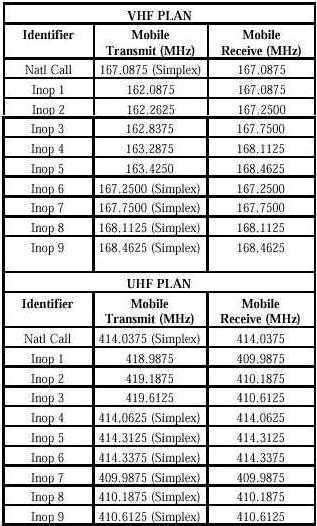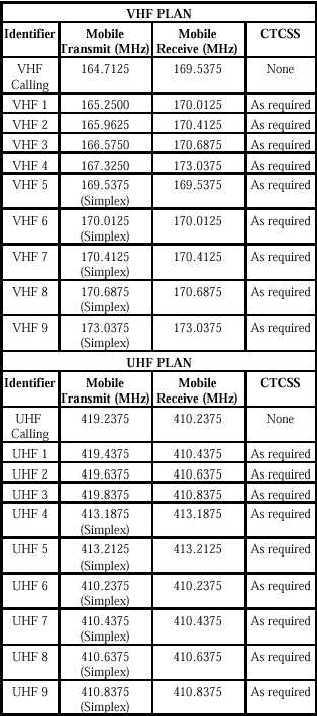|
|
|
4.3.16 Plans for Interagency Law Enforcement and Incident Response Operations in the Bands 162-174 MHz and 406.1-420 MHz
CONDITIONS FOR USE
1. The frequencies
shown in this plan are available for assignment to all Government agencies
to satisfy intermittent law enforcement and public
safety incident
response requirements. Non-Government agencies may use these frequencies
only in cooperation with agencies of the Federal Government. Federal agencies
will provide written certification to non-Government agencies indicating
that the non-Government operation is necessary. Non-Government entities
will be advised in the written
certification
that under Federal law they are required to obtain a license from the Federal
Communications Commission (FCC) for such operations, and
that the
FCC File Number for the license, once obtained, will be provided to the
Government agency providing the written certification. A copy of
this certification
will also be submitted to the NTIA Public Safety Program Office. Federal
agencies shall comply with the requirements of Section
2.3.12 of
this Manual. The frequencies are available on a shared basis and will not
be authorized for the exclusive use of any one agency.
2. All Government operations shall be authorized in accordance with Chapter 9 of this Manual. The FCC will submit all non-Government applica-tions to the Frequency Assignment Subcommittee (FAS) for approval.
3. Base stations are authorized use of the mobile transmit frequencies for access to fixed stations, e.g., repeaters. Mobile stations are permitted to use fixed station transmit frequencies for talk-around communications.
4. The following restrictions apply:
(a) the minimum
ERP necessary to support the intended use shall be employed;
(b) the maximum
base or mobile transmitter output power shall not exceed 125 Watts; and
(c) the gain
of the base station antenna shall not exceed 6 dBi.
5. Exceptions to the above restrictions will be considered by the FAS on a case-by-case basis.
LAW ENFORCEMENT PLANS
1. Frequencies
167.0875 MHz and 414.0375 MHz are designated as National Calling Channels
for initial contact and will be identified in the radio
as indicated
in paragraph 2 below. Initial contact communications will be established
using analog FM emission (11KF3E). The agency in control of the
incident
will assign specific operational channels as required for incident support
operations.
2. The interoperability
frequencies will be identified in mobile and portable radios as follows
with Continuous Tone-Controlled Squelch Systems
(CTCSS) frequency
167.9 Hz and/or Network Access Code (NAC) $68F:

3. All applications
using these allotted frequencies shall be affixed with Record Note S397.
This assignment is for a joint law enforcement require-ment pursuant to
Section 4.3.16 of this Manual.
INCIDENT RESPONSE PLANS
1. Frequencies 169.5375 MHz, paired with 164.7125 MHz, and 410.2375 MHz, paired with 419.2375 MHz, are designated as the calling channels for initial contact and will be identified in the radio as indicated in paragraph 2. Initial contact will be established using analog FM emission (11KF3E). CTCSS will not be used on the calling channels to ensure access by stations from outside the normal area of operation. The agency in control of the incident will assign specific operational channels as required for incident support operations.
2. The Interoperability frequencies will be identified in mobile and portable radios as follows:

3. All applications
using these allotted frequencies shall be affixed with Record Note S397.
This assignment is for a joint incident response requirement pursuant to
Section 4.3.16 of this Manual.